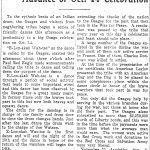October 10, 1929
The Daily Journal Capital
Microfilm Roll: MN00280
On this day in Osage country in 1929, four days ahead of the annual October 14th celebration, an Osage ceremonial dance, I’n-Lon-Schka, began.
According to the article, the October 14th celebration was held to commemorate the day the Osages were recognized by President Coolidge and the American Legion for their efforts in the First World War. During the Great War, Osages alone bought over $2,250,000 dollars of Liberty Bonds, amounting to over $33,000,000 in today’s dollars. Furthermore, Osage tribal members volunteered and donated much of their time and money to organizations such as the Red Cross and the Salvation Army. This is of course not to mention the over two hundred Osages who fought on the front lines during the war.
I’n-Lon-Schka, literally means “playground-of-the-first-son”, is an Osage ceremonial dance that usually takes place in June. The Osage adopted the dance from the Ponca and Kaw Indians after their removal to Indian Territory. However according to John Joseph Mathews, “I’n-Lon-Schka was originally a Siouan dance” (Mathews 781). The ceremony consists of song, dance, and music each with an important role, although the drum is perhaps the most significant aspect of the I’n-Lon-Schka.
Morgan M. Guzman
“Osages Begin Dances Today in Advance of Oct. 14 Celebration.” The Daily Journal-Capital. October 10, 1929, p. 1. Microfilm roll number MN00280. Sequoyah National Research Center, Little Rock, Arkansas.
Further Reading
Mathews, John Joseph. The Osages: Children of the Middle Waters. Norman: University of Oklahoma Press 1961.
Ruckman, S.E. “Drum Ceremony Unites Osage.” Tulsa World. http://www.tulsaworld.com/archives/drum-ceremony-unites-osage/article_b4546067-e46b-5db4-871e-3d010e5f176a.html Accessed February 13, 2018.
Tinker, George E. “The Osage Ceremonial Dance I’n-Lon-Schka by Alice Ann Callahan.” American Indian Quarterly 16, no. 3, (1992): 436-437. Accessed February 13, 2018. http://www.jstor.org/stable/1185818
Source File(s)
Related Stories
- Indians Holding 4-Day Celebration
- Indians Open Big Festival near Pawhuska
- Indians Show at Tulsa Exposition
